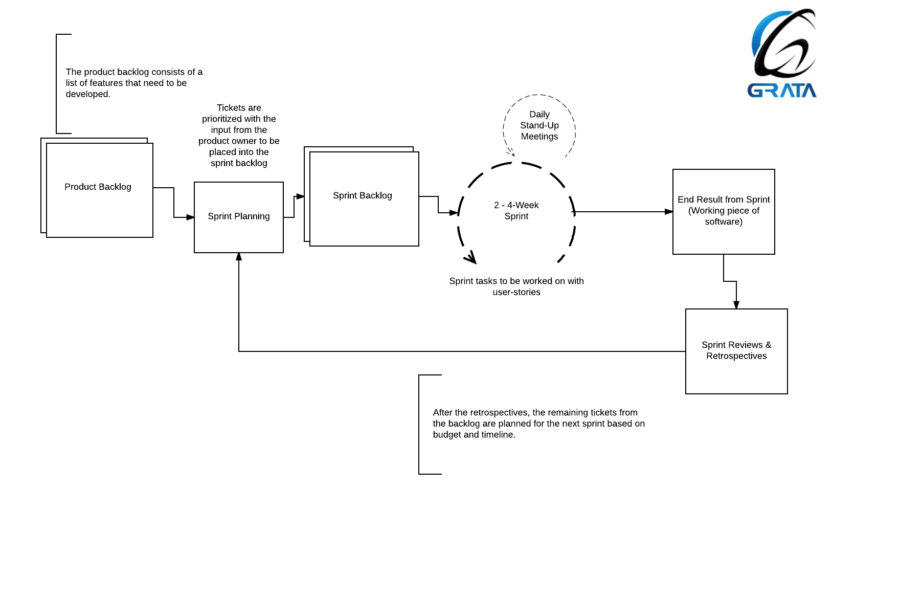What Is Scrum
Scrum is an Agile framework with a lightweight, iterative approach to software development. It is best when in complex projects. Scrum is easy to understand but can be challenging to master.
Getting yourself acclimated with Scrum requires understanding the Scrum life cycle. Having the right team members to fulfill the roles you need for Scrum is crucial to running Scrum successfully.
The flow of the Scrum life cycle consists of the following parts:
- Product Backlog
- Sprint Planning
- The Sprint Backlog
- Sprint
- Daily Scrum
- Sprint Review
- Sprint Retrospective
Product Backlog
The product backlog is a list of things your team needs to do for a project. It is also a wish list since the product owner would ideally like all items on the list to be worked on. Moreover, the product backlog is similar to listing out requirements and specifications for a project.
Subsequently, the product owner prioritizes the list and breaks it out into tickets with details that could be technical or in the form of user stories. Also, the product backlog changes throughout the project as the owner adds, modifies, or deletes requirements. The product owner is responsible for keeping the product backlog current.
Sprint Planning
Sprint planning is a meeting between the Scrum Master, the Product Owner, and the rest of the Agile team. It is usually an hour at maximum, and the team members meet to discuss and plan the tickets they will work on from the product backlog.
Additionally, they discuss acceptance criteria and estimate the effort the team needs to perform. They usually plan top priority tickets first, and if there is room for lesser priority tickets, they add them after. What the team takes on is dependent on the length of the sprint, the team’s capacity, and velocity. The final tickets that they agree on will go into the sprint backlog.
Sprint Backlog
The sprint backlog is the list of tasks/tickets agreed on by the Scrum team to be completed within a sprint. These define the sprint backlog size based on the Scrum team’s commitments. During a sprint, the product owner tracks and updates the backlog regularly with any new information about the work the team is doing. Sometimes, too much or too little work can be planned for a sprint backlog. When this happens, someone must either be removed or add tickets to the backlog to balance the sprint.
Sprints
A sprint is a time-boxed period in which work needs to be completed and ready for review.
In Scrum, the sprint length is usually based on how a team works and how quickly they need to provide working pieces of software. Sprints can be as short as one week or four weeks. The Scrum Master usually determines the length of a sprint with agreements from the team. Once the Scrum Master sets the size, it should continue for all future sprints.
Daily Scrum
Daily scrum or daily stand-up is a fifteen-minute time-boxed meeting. A daily scrum meeting happens every day at the same time and location. This is an opportunity for the development team to discuss what they did the day before, what they will be working on, and what obstacles impede their progress.
Generally, the Scrum Master is the facilitator. The meeting is meant for all team members to share their input on the sprint and clearly understand what the team worked on, what issues need resolving, and what is left to do. This will give insight into the sprint’s progress and indicate if the commitments and goals are being met.
Sprint Review
At the end of each sprint, the team is responsible for providing a working piece of software that is potentially shippable. Because of this, sprint review meetings are usually held for the team to demonstrate what they did during the sprint and to get feedback from the product owner and other stakeholders. The final result is weighed against the initial sprint goal, and the team can use this time to provide suggestions on what was accomplished. Sprint reviews should be a manageable length and should fall anywhere between one to two hours maximum.
Sprint Retrospective
A sprint retrospective is an internal meeting for the Scrum team. Chiefly, it is an opportunity for the team to reflect on how they did in the sprint and determine ways to improve. Retrospectives should also be time-boxed but still allow all team members to provide their input.
There are different ways in which you can carry out retrospectives. One way is to use the Start, Stop, Continue technique, where each team member, based on their experience in the sprint, suggests what the team should start doing, stop doing, and continue doing. Retrospectives are the last step in the Scrum life cycle and happen at the end.
References:
O’Connell, K. (2017, July 18). Scrum: Advanced. Retrieved September 28, 2017, from https://www.lynda.com/Business-Skills-tutorials/Scrum-Advanced/550574-2.html
O’Connell, K. (2017, March 23). Scrum: The Basics. Retrieved September 28, 2017, from https://www.lynda.com/Business-Skills-tutorials/Scrum-Basics/550619-2.html
Scrum Alliance. (n.d.). Learn About Scrum. Retrieved September 27, 2017, from https://www.scrumalliance.org/why-scrum
Scrum Alliance. (n.d.). The Scrum Guide. Retrieved September 28, 2017, from https://www.scrumalliance.org/why-scrum/scrum-guide

